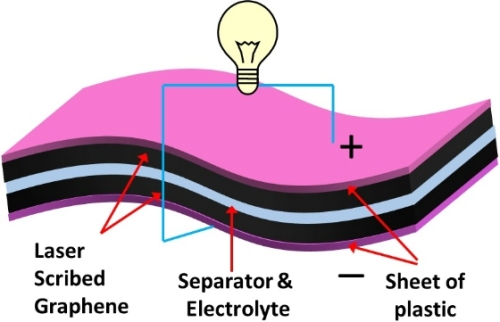A research team from the University of California- Los Angeles (UCLA) has developed novel graphene-based electrodes with higher conductivity and surface area utilizing a typical LightScribe DVD optical drive.
 Schematic showing the structure of laser scribed graphene ultracapacitors
Schematic showing the structure of laser scribed graphene ultracapacitors
These electrodes are helpful in designing electrochemical capacitors that combines the battery’s high energy density and the capacitor’s power performance, paving the way to advance energy storage technology. The research team showed the high-performance electrochemical capacitors made of graphene. These electrochemical capacitors, also called as ultracapacitors or supercapacitors, retain superior electrochemical qualities even under high mechanical stress, making them suitable for high-power flexible electronics. The study results have been reported in Science.
In the UCLA’s process, graphene electrodes are fabricated by laser treating a DVD disc coated with a graphite oxide film inside a LightScribe DVD drive. Devices featuring laser scribed graphene (LSG) electrodes made of expanded graphene network demonstrate ultrahigh energy density in various electrolytes, while retaining the outstanding cycle stability and high power density of ultracapacitors. The LSG ultracapacitors have a substantial charge storage capacity due to the higher surface area of the LSG electrodes. They can offer ultrahigh power within in a shorter period due to the electrode’s open network structure that reduces the electrolyte ions’ diffusion path, which is critical to charge the device.
Moreover, the LSG electrodes are mechanically stronger and have higher conductivity than activated carbons used in conventional ultracapacitors, thus eliminating the necessity for a binder or current collector.
The use of a polymer gelled electrolyte simplifies the fabrication process by eliminating the use of special packaging materials, and decreases the thickness of the device by functioning as a separator.